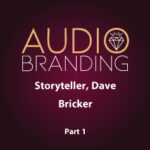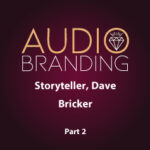Music can have a powerful effect on our feelings, our behavior, even how we see the world around us. But what if music itself can react to our feelings? Weav Run, an award-winning workout app that instantaneously adjusts a song’s tempo to match the listener’s own pace, offers just one example of the fascinating potential of dynamic music.
When it comes to audio branding, music’s usually thought of as the product – and the audience is just a passive consumer. You can listen to a song and let its melody carry you through the highs and lows, but no matter how many times you listen, those highs and lows aren’t ever going to change. The song is the song, and changing the mood a soundtrack sets usually just means switching to a different song. Dynamic music, however, seeks to reinvent that relationship by enabling a single audio track to evolve and reflect each individual listener, whether it’s by matching your walking pace, or detecting and following the rhythm of your heartbeat or breathing rate, or even measuring changes in your brain activity. Slow and thoughtful, lively and upbeat or quick and energetic, dynamic music allows a song to remain instantly recognizable while engaging us on a surprisingly personal level.
Just check out this video demonstration of Weav Music’s exercise app Weav Run, which won the 2019 International Sound Award for Service and Sound start-ups:
As you can see, it’s not just about speeding up or slowing down the music: there’s a very tricky balancing act to consider between the pitch, tempo and even the composition of the song so that it remains appealing – and recognizable – in a variety of forms. Managing those sorts of second-by-second changes, and doing it so quickly that the listener doesn’t even notice it’s happening, is a pretty new development that’s gotten a really big push from smartphones, mobile devices and our always connected, on-the-go world.
Still, the idea of it has been around for quite a while: just think of an opera, where a whole orchestra’s focused on just keeping pace with the action on the stage. But the idea of doing this automatically and in real time, for each and every person, really got its start with early computer games, where programmers had to come up with some very inventive audio techniques to allow the music to seamlessly shift from one situation to the next. Here’s an example of one such technique called vertical re-orchestration that uses hidden bridges to move back and forth between slightly different versions of a single melody:
If you think about it, video games are really all about influencing a person’s behavior and creating an immersive, dynamic environment that draws them into the experience, which is just the sort of engagement that audio branding seeks to create as well. As the intersection between technology, art and lifestyle continues to expand, that sort of approach is becoming more and more relevant, not just in virtual environments but in our everyday lives as well. For instance, Sync Project, a Boston audio startup acquired by Bose in 2018, has been developing technology that adapts music to a listener’s real-time biometric data to help them relax, to fall asleep, even manage chronic pain and other medical conditions:
If you’d like to see how it works, give it a try here:
https://unwind.syncproject.co/
Music can have a very real, even medical impact on our brains and bodies. Just listening to a favorite song can trigger the release of endorphins in much the same way exercise does, and releases neurochemicals such as dopamine and oxytocin, promoting a sense of well-being and reward and actually blocking pain receptors to reduce stress. This effect is so potent that music therapy is currently being researched as an alternative to opioid prescriptions. The potential for dynamic music to utilize and finely tune this effect for each listener could have enormous implications for everything from audio marketing to the entertainment industry to healthcare.
Audio technology’s evolving at an unprecedented rate, and in ways we hardly could have considered a decade or two ago. Today we can go jogging with the Weav Run app and, instead of simply keeping up with the music, the music itself keeps up with us, changing and flowing to reflect our own experience in the moment. We’re entering an era in which listeners no longer simply listen to and consume music, but engage with that music on a physical, personal level, weaving it more and more deeply into the fabric of our lives.
Would you consider reviewing the Audio Branding Podcast? If so, here’s the Apple Podcast link: https://podcasts.apple.com/podcast/audio-branding/id1489042453 And if you like what you hear (and read!) – please do share it with anyone you think might be interested. Thanks so much!
And if you’re interested in crafting an audio brand for your business, why not check out my FREE download – 5 Tips For Implementing An Intentional Audio Strategy at https://voiceoversandvocals.com/audio-branding-strategy/

